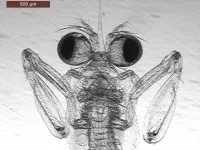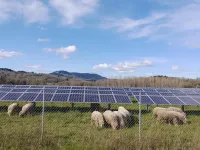(Press-News.org) DURHAM, N.C. - Mantis shrimp don't need baby food. They start their life as ferocious predators who know how to throw a lethal punch.
A new study appearing April 29 in the Journal of Experimental Biology shows that larvae of the Philippine mantis shrimp (Gonodactylaceus falcatus) already display the ultra-fast movements for which these animals are known, even when they are smaller than a short grain of rice.
Their ultra-fast punching appendages measure less than 1 mm, and develop right when the larva exhausts its yolk reserves, moves away from its nest and out into the big wide sea. It immediately begins preying on organisms smaller than a grain of sand.
Although they accelerate their arms almost 100 times faster than a Formula One car, Philippine mantis shrimp larvae are slower than larger adults, which goes against the theoretical expectation that smaller is always faster.
"They're producing amazing speeds and impressive accelerations relative to their body size, but they're not as fast as adults," said Jacob Harrison, a PhD candidate in biology at Duke University and lead author of the study.
Mantis shrimps achieve their ultra-fast movements through a tiny spring-actuated mechanism hidden in their punching appendage. A muscle contracts, deforming a tiny segment of their exoskeleton -the rigid cuticle that covers their body. This contraction allows elastic energy to be stored in the locked joint. Once the latch releases, the exoskeleton springs back into its natural position, violently propelling the appendage forward with ultra-fast speeds.
Engineering and physics models predict that smaller organisms, who have a smaller mass to displace, will be faster than larger, heavier, organisms. Mantis shrimp larvae show that biology doesn't always follow the theory.
"Theoretically, they should be producing the highest acceleration," said Harrison, "but we don't find that."
Harrison explains that this discrepancy may be due to multiple factors. The larvae muscles may be too small to effectively load a very stiff spring, or the water resistance at their small size may be too high for their punches to reach the speed that larger individuals reach, among other possibilities.
"There are limitations to these spring and latch structures that we don't fully understand," said Harrison. "But whenever biology moves away from theoretical models it highlights some pretty interesting areas for us to learn."
Mantis shrimp larvae are an interesting system not only due to their small size, but also due to their color, or lack thereof.
Adult mantis shrimps have opaque exoskeletons, rendering the inner working of their spring-latch mechanisms impossible to observe in action. The exoskeleton of larvae, however, is much thinner and fully transparent, allowing researchers to see precisely how these animals manage to store so much elastic energy in their tiny appendages simply by watching them through a microscope.
"One of the trickiest parts of researching spring-actuated mechanisms is that a lot of those elements are working inside the animal. We can look outside of the animal and see the behavior, measure the kinematics, dissect the animal, and say the mechanism looks like it works like this, but there are always levels of assumption," said Harrison.
"(Transparency) sets up larval mantis shrimps as systems where we can look at how each of these elements work in concert together," said Harrison. "It removes assumptions and allows us to understand it on a finer scale."
Larval mantis shrimps are therefore doubly interesting. They highlight discrepancies between physics and biology, and also offer a true window into a better understanding of the mechanism behind ultra-fast movements.
"When something doesn't match your predictions, the first gut reaction is always to be incredibly frustrated, but this is actually what highlights new areas of research," said Harrison.
INFORMATION:
This work was supported by the Company of Biologists Traveling Fellowship (JEBTF181185), by the National Science Foundation (NSF IOS 1439850 and NSF EPSCoR RII 455 1738567), by the Office of Naval Research (N00014-19-1-2035 and N00014-454 17-1-2062), and by the University of Hawai'i at Mānoa. This material is based upon work supported by, or in part by, the U.S. Army Research Laboratory and the U.S. Army Research Office under contract/grant number W911NF-15-1-058.
CITATION: "Scaling and development of elastic mechanisms: the tiny strikes of larval mantis shrimp," J. S. Harrison, M. L. Porter, M. J. McHenry, H. E. Robinson, S. N. Patek. Journal of Experimental Biology, April 29, 2021. DOI: 10.1242/jeb.235465
CORVALLIS, Ore. - Land productivity could be greatly increased by combining sheep grazing and solar energy production on the same land, according to new research by Oregon State University scientists.
This is believed to be the first study to investigate livestock production under agrivoltaic systems, where solar energy production is combined with agricultural production, such as planting agricultural crops or grazing animals.
The researchers compared lamb growth and pasture production in pastures with solar panels and traditional open pastures. They found less overall but higher quality forage in the solar pastures and that lambs raised in each pasture type ...
ROCHESTER, Minn. -- The Mayo Clinic data scientists who developed highly accurate computer modeling to predict trends for COVID-19 cases nationwide have new research that shows how important a high rate of vaccination is to reducing case numbers and controlling the pandemic.
Vaccination is making a striking difference in Minnesota and keeping the current level of positive cases from becoming an emergency that overwhelms ICUs and leads to more illness and death, according to a study published in Mayo Clinic Proceedings. The study, entitled "Quantifying the Importance of COVID-19 Vaccination to Our Future Outlook," outlines how Mayo's COVID-19 predictive modeling can assess future trends based on the pace of vaccination, and how vaccination trends are crucial ...
Venus is an enigma. It's the planet next door and yet reveals little about itself. An opaque blanket of clouds smothers a harsh landscape pelted by acid rain and baked at temperatures that can liquify lead.
Now, new observations from the safety of Earth are lifting the veil on some of Venus' most basic properties. By repeatedly bouncing radar off the planet's surface over the last 15 years, a UCLA-led team has pinned down the precise length of a day on Venus, the tilt of its axis and the size of its core. The findings are published today in the journal Nature Astronomy.
"Venus is our sister planet, and yet these fundamental properties have remained unknown," said Jean-Luc Margot, a UCLA professor of Earth, planetary and space sciences who led the research.
Earth ...
Immunotherapies that fight cancer have been a life-saving advancement for many patients, but the approach only works on a few types of malignancies, leaving few treatment options for most cancer patients with solid tumors. Now, in two related papers published April 28, 2021 in Science Translational Medicine, researchers at UCSF have demonstrated how to engineer smart immune cells that are effective against solid tumors, opening the door to treating a variety of cancers that have long been untouchable with immunotherapies.
By "programming" basic computational abilities into immune cells that are designed to attack cancer, the researchers have overcome a number of major hurdles that have kept these strategies ...
The decision to donate to a charity is often driven by emotion rather than by calculated assessments based on how to make the biggest impact. In a review article published on April 29 in the journal Trends in Cognitive Sciences, researchers look at what they call "the psychology of (in)effective altruism" and how people can be encouraged to direct their charitable contributions in ways that allow them to get more bang for the buck--and help them to have a larger influence.
"In the past, most behavioral science research that's looked at charitable giving has focused on quantity and how people might be motivated to give more money to charity, or to give at all," says first author Lucius Caviola (@LuciusCaviola), a postdoctoral researcher in the Department of Psychology at Harvard University. ...
Scientists in China have developed a small, flexible device that can convert heat emitted from human skin to electrical power. In their research, presented April 29 in the journal Cell Reports Physical Science, the team showed that the device could power an LED light in real time when worn on a wristband. The findings suggest that body temperature could someday power wearable electronics such as fitness trackers.
The device is a thermoelectric generator (TEG) that uses temperature gradients to generate power. In this design, researchers use the difference between the warmer body temperature and the relatively cooler ambient environment to generate power.
"This is a field with great potential," says corresponding author Qian Zhang of Harbin ...
It may seem like an unusual place to go looking for answers, but the contents of a baby's first diaper can reveal a lot about a newborn's future health.
In a new study published today in Cell Reports Medicine, a team of University of British Columbia (UBC) researchers has shown that the composition of a baby's first poop--a thick, dark green substance known as meconium--is associated with whether or not a child will develop allergies within their first year of life.
"Our analysis revealed that newborns who developed allergic sensitization by one year of age had significantly less 'rich' meconium at birth, compared to those who didn't develop allergic sensitization," says the study's senior co-author Dr. Brett Finlay, a professor at the Michael Smith ...
Although robotic devices are used in everything from assembly lines to medicine, engineers have a hard time accounting for the friction that occurs when those robots grip objects - particularly in wet environments. Researchers have now discovered a new law of physics that accounts for this type of friction, which should advance a wide range of robotic technologies.
"Our work here opens the door to creating more reliable and functional haptic and robotic devices in applications such as telesurgery and manufacturing," says Lilian Hsiao, an assistant professor of chemical and biomolecular engineering at North Carolina State University and corresponding author of a paper on the work.
At ...
The best path across the desert is rarely the straightest. For the first human inhabitants of Sahul -- the super-continent that underlies modern Australia and New Guinea -- camping at the next spring, stream, or rock shelter allowed them to thrive for hundreds of generations. Those who successfully traversed the landmarks made their way across the continent, spreading from their landfall in the Northwest across the continent, making their way to all corners of Australia and New Guinea.
By simulating the physiology and decisions of early way-finders, an international team* of archaeologists, geographers, ecologists, and computer scientists has mapped the probable "superhighways" that led ...
BOSTON - Concerns about fertility often influence how young women with breast cancer approach treatment decisions and are a reason for forgoing or delaying hormone-blocking therapy, a new study by Dana-Farber Cancer Institute investigators shows.
The findings, published online today by the journal Cancer, reinforce the need for physicians to talk with patients about their fertility-related priorities and address them in treatment plans, the study authors write. Such conversations are important not only at the start of treatment but during its entire course, as patients' goals ...




